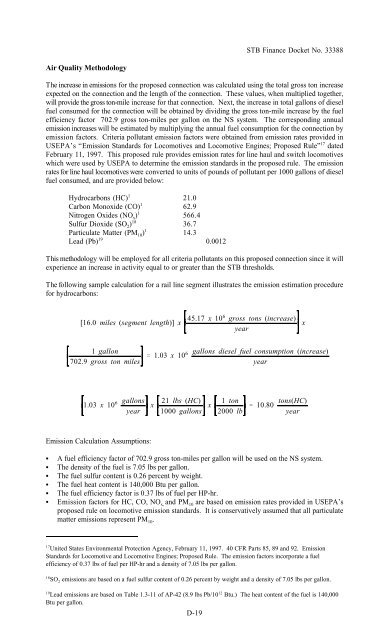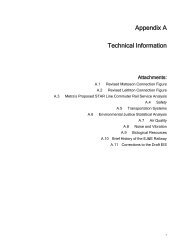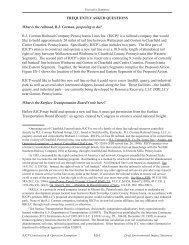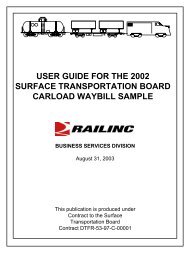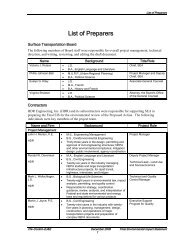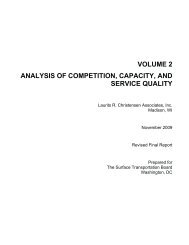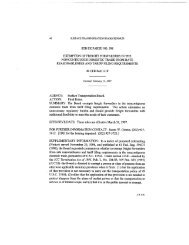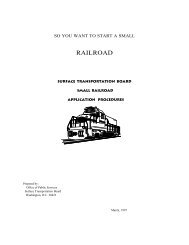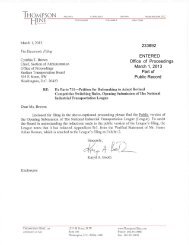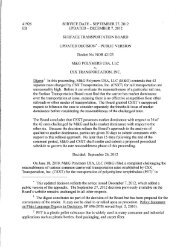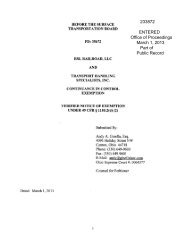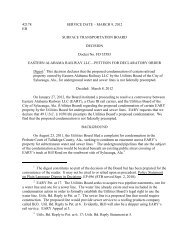Norfolk Southern/Conrail Rail ConnectionâBucyrus, Ohio - Surface ...
Norfolk Southern/Conrail Rail ConnectionâBucyrus, Ohio - Surface ...
Norfolk Southern/Conrail Rail ConnectionâBucyrus, Ohio - Surface ...
Create successful ePaper yourself
Turn your PDF publications into a flip-book with our unique Google optimized e-Paper software.
STB Finance Docket No. 33388<br />
Air Quality Methodology<br />
The increase in emissions for the proposed connection was calculated using the total gross ton increase<br />
expected on the connection and the length of the connection. These values, when multiplied together,<br />
will provide the gross ton-mile increase for that connection. Next, the increase in total gallons of diesel<br />
fuel consumed for the connection will be obtained by dividing the gross ton-mile increase by the fuel<br />
efficiency factor 702.9 gross ton-miles per gallon on the NS system. The corresponding annual<br />
emission increases will be estimated by multiplying the annual fuel consumption for the connection by<br />
emission factors. Criteria pollutant emission factors were obtained from emission rates provided in<br />
17<br />
USEPA’s “Emission Standards for Locomotives and Locomotive Engines; Proposed Rule” dated<br />
February 11, 1997. This proposed rule provides emission rates for line haul and switch locomotives<br />
which were used by USEPA to determine the emission standards in the proposed rule. The emission<br />
rates for line haul locomotives were converted to units of pounds of pollutant per 1000 gallons of diesel<br />
fuel consumed, and are provided below:<br />
1<br />
Hydrocarbons (HC) 21.0<br />
1<br />
Carbon Monoxide (CO) 62.9<br />
1<br />
Nitrogen Oxides (NO x) 566.4<br />
18<br />
Sulfur Dioxide (SO 2) 36.7<br />
1<br />
Particulate Matter (PM 10) 14.3<br />
19<br />
Lead (Pb) 0.0012<br />
This methodology will be employed for all criteria pollutants on this proposed connection since it will<br />
experience an increase in activity equal to or greater than the STB thresholds.<br />
The following sample calculation for a rail line segment illustrates the emission estimation procedure<br />
for hydrocarbons:<br />
[16.0 miles (segment length)] x 45.17 x 106 gross tons (increase)<br />
year<br />
x<br />
1 gallon<br />
702.9 gross ton miles<br />
' 1.03 x 10 6<br />
gallons diesel fuel consumption (increase)<br />
year<br />
1.03 x 10 6 gallons<br />
year<br />
x<br />
21 lbs (HC)<br />
1000 gallons<br />
x<br />
1 ton<br />
2000 lb<br />
' 10.80<br />
tons(HC)<br />
year<br />
Emission Calculation Assumptions:<br />
C<br />
C<br />
C<br />
C<br />
C<br />
C<br />
A fuel efficiency factor of 702.9 gross ton-miles per gallon will be used on the NS system.<br />
The density of the fuel is 7.05 lbs per gallon.<br />
The fuel sulfur content is 0.26 percent by weight.<br />
The fuel heat content is 140,000 Btu per gallon.<br />
The fuel efficiency factor is 0.37 lbs of fuel per HP-hr.<br />
Emission factors for HC, CO, NOx, and PM 10 are based on emission rates provided in USEPA’s<br />
proposed rule on locomotive emission standards. It is conservatively assumed that all particulate<br />
matter emissions represent PM 10.<br />
17 United States Environmental Protection Agency, February 11, 1997. 40 CFR Parts 85, 89 and 92. Emission<br />
Standards for Locomotive and Locomotive Engines; Proposed Rule. The emission factors incorporate a fuel<br />
efficiency of 0.37 lbs of fuel per HP-hr and a density of 7.05 lbs per gallon.<br />
18<br />
SO emissions are based on a fuel sulfur content of 0.26 percent by weight and a density of 7.05 lbs per gallon.<br />
2<br />
19 12<br />
Lead emissions are based on Table 1.3-11 of AP-42 (8.9 lbs Pb/10 Btu.) The heat content of the fuel is 140,000<br />
Btu per gallon.<br />
D-19


